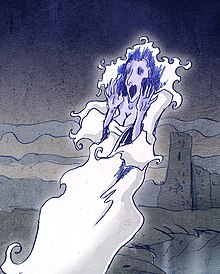Banshee

A banshee (/ˈbænʃiː/ BAN-shee, from Template:Lang-sga, pronounced [bʲæn ˈʃiː], "woman of the síd"[1]) is a female spirit in Irish mythology, who heralds the death of a member of one of the prominent Gaelic families, usually by shrieking or keening.
Description
The banshee is often described in Gaelic lore as wearing red or green, usually with long, disheveled hair. She can appear in a variety of forms. Perhaps most often she is seen as an ugly, frightful hag, but she can also appear as young and beautiful if she chooses. In some tales, the figure who first appears to be a banshee or other cailleach (hag) is later revealed to be the Irish battle goddess, the Morrígan.
Keening
In Ireland and parts of Scotland, a traditional part of mourning is the keening woman (bean chaointe), who wails a lament - a Template:Lang-ga, [ˈkɰiːnʲə] or [ˈkiːnʲuː], caoin meaning "to weep, to wail". This keening woman may in some cases be a professional, and the best keeners would be in high demand. Legend has it that for great Gaelic families – the O'Gradys, the O'Neills, the Ó Longs, the McCnaimhíns, the O'Briens the Ó Conchobhairs, and the Caomhánachs – the lament would be sung by a fairy woman; having foresight, she would sing it when a family member died, even if the person had died far away and news of their death had not yet come, so that the wailing of the banshee was the first warning the household had of the death. In later versions, the banshee might appear before the death and warn the family by wailing.
When several banshees appear at once, it indicates the death of someone great or holy.[2] The tales sometimes recounted that the woman, though called a fairy, was a ghost, often of a specific murdered woman, or a mother who died in childbirth.[3]
Origin

The Ua Briain banshee is thought to be named Aibell and the ruler of 25 other banshees who would always be at her attendance.[4] It is possible that this particular story is the source of the idea that the wailing of numerous banshees signifies the death of a great person.[4]
Most, though not all, surnames associated with banshees have the Ó or Mc/Mac prefix - that is, surnames of Goidelic origin, indicating a family native to the Insular Celtic lands rather than those of the Norse, English, or Norman invaders. Accounts reach as far back as 1380 to the publication of the Cathreim Thoirdhealbhaigh (Triumphs of Torlough) by Sean mac Craith.[4] Mentions of banshees can also be found in Norman literature of that time.[4]
In some parts of Leinster, she is referred to as the bean chaointe (keening woman) whose wail can be so piercing that it shatters glass. In Scottish folklore, a similar creature is known as the bean nighe or ban nigheachain (little washerwoman) or nigheag na h-àth (little washer at the ford) and is seen washing the bloodstained clothes or armour of those who are about to die. In Welsh folklore, a similar creature is known as the Hag of the mist.[5]
See also
Notes
References
- ^ Dictionary of the Irish Language: síd, síth and ben
- ^ Yeats, W. B. "Fairy and Folk Tales of the Irish Peasantry" in Booss, Claire; Yeats, W.B.; Gregory, Lady (1986) A Treasury of Irish Myth, Legend, and Folklore. New York: Gramercy Books. p. 108. ISBN 978-0-517-48904-8
- ^ Briggs (1976), pp. 14–16: "Banshee"
- ^ a b c d Westropp, Thos. J. (June 1910). "A Folklore Survey of County Clare". Folklore. 21. Taylor & Francis: 180–199. JSTOR 1254686.
- ^ Owen, Elias (1887). Welsh folk-lore: A collection of the folk-tales and legends of North Wales. Felinfach: Llanerch. p. 142.
Further reading
- Sorlin, Evelyne (1991). Cris de vie, cris de mort: Les fées du destin dans les pays celtiques (in French). Academia Scientiarum Fennica. ISBN 978-951-41-0650-7.
- Lysaght, Patricia (1986). The banshee: The Irish death-messenger. Roberts Rinehart. ISBN 978-1-57098-138-8.
- Briggs, Katharine (1976). An encyclopedia of fairies: Hobgoblins, brownies, bogies, and other supernatural creatures. Pantheon. ISBN 978-0-394-73467-5.
- Evans-Wentz, Walter Yeeling (1977). The Fairy-Faith in celtic countries, its psychological origin and nature. C. Smythe. OCLC 257400792
External links
- Chisholm, Hugh, ed. (1911). . Encyclopædia Britannica (11th ed.). Cambridge University Press.
